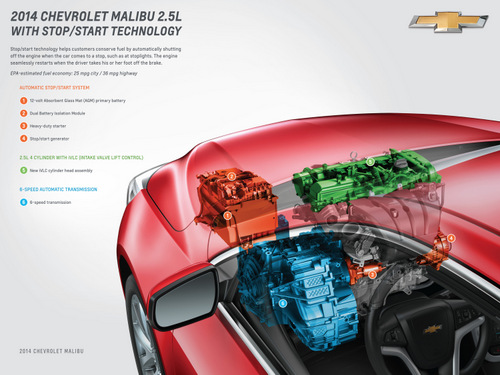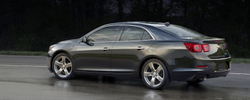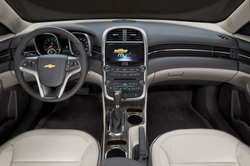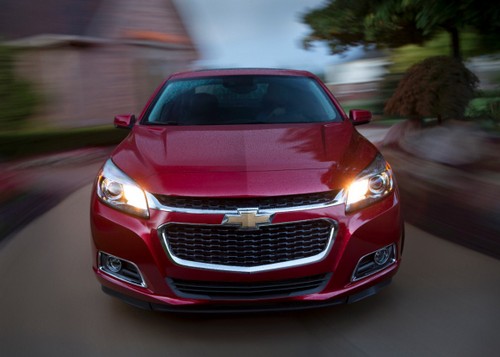Now With Fuel Economy Standard

(Editor’s Note: This is the third in a series about vehicles with start-stop technology. See the others here and here; the background on start-stop systems is here)
Chevrolet launched an all-new Malibu for the 2013 model year, but it was less successful at winning sales than Chevy had hoped. In an attempt to increase its appeal, a revised 2014 Malibu has a new look outside and in, including a freshened front-end and, inside, a redesigned center console and a roomier rear seat.
But the changes go beyond cosmetic.
Malibu peeked into the parts bin of its bigger brother, the 2014 Impala, and picked up suspension enhancements that Chevy says improves Malibu’s overall driving refinement. To satisfy enthusiast drivers, engineers tweaked Malibu’s optional 2.0-liter turbo four resulting in a 14-percent increase in torque – 295 pounds-feet, up from 260.

Also, several new safety features are available for 2014, including Side Blind Zone and Rear Cross Traffic alerts.
But wait, there’s more.
In a somewhat surprising move, the entry-level Malibu LS now comes standard with a start-stop system, the first midsize sedan sold in the United States that is so equipped. Combined with refinements of its base 2.5-liter four-cylinder engine and a new six-speed automatic transmission, the LS has a significant fuel economy increase compared with the outgoing model (now 25 city; 36 highway).
The fuel-saving and emissions- reducing feature has become commonplace in Europe, where it’s estimated that 40 to 45 percent of vehicles use the technology to meet European emission regulations (a number destined to grow to 100 percent).
Start-stop has been slow to catch on with U.S. automakers in part because of cost. For example, it is a $295 option on the Malibu’s competition – the 2014 Ford Fusion.
Another reason is that the driving cycles established by the Environmental Protection Agency, which help determine mileage ratings for cars and trucks, don’t have an appropriate test to gauge a start-stop system’s effectiveness on mileage ratings.
When asked why Chevy included start-stop on the Malibu LS, Chad Lyons, Chevrolet communications manager said, “Customers are sensitive to fuel economy and we think it just makes sense.” In other words, whether it shows up on the mileage on the window label, Malibu buyers will get better fuel economy in the real world.
And the 2014 Malibu with start-stop will help General Motors to meet more stringent Corporate Average Fuel Economy (CAFE) standards are set for 2016.
Malibu Stop-Start System
The Malibu’s start-stop falls under the category of a “light stop-start system.” Like other systems, the Malibu’s start-stop operates automatically and doesn’t require any input from the driver. It helps conserve fuel by shutting off the engine when the car comes to a stop, such as at stoplights. The engine automatically restarts when the driver takes his or her foot off the brake.
Todd Pawlik, Malibu chief engineer, stated that leveraging knowledge from the system used in eAssist (Buick LaCrosse and Regal) was key to improving city fuel ratings by 3 mpg, or five percent.

The system consists mainly of a beefed-up starter and a small auxiliary battery located behind the right rear wheel.
When the Malibu comes to a stop, an auxiliary electric transmission fluid pump maintains pressure in preparation for the “auto start” launch.
Ensuring quick, smooth start-ups from stop, the reinforced starter motor has a tandem solenoid. It supports change of mind operation by allowing the pinion placement and starter rotation to be controlled independently.
Employing absorbed glass mat (AGM) technology, the auxiliary battery’s purpose is to supply power to the vehicle’s electrical systems (not including the starter motor) for the brief moments when the engine is being re-started.
The start-stop system monitors – among other things – vehicle speed, climate control system operation and the force a driver applies to the brake pedal, to determine whether it is efficient to shut off the engine in certain driving conditions. For example, if a driver is creeping along at speeds less than 6 mph, with frequent brief braking as in stop-and-go traffic situations, the engine does not shut down so as to not inconvenience the driver.
Most vehicles with start-stop have a shut-off switch allowing drivers to simply turn it off if they’re not happy with it. The Malibu does not have an optional kill switch.
Under The Hood
Start-stop isn’t the only 2014 Malibu fuel-saving enabler. The car receives an improved Ecotec 2.5-liter four-cylinder engine that also is used in the recently launched 2014 Impala.
The 2.5 continues with direct injection and variable valve timing, but for 2014 engineers incorporated a new valvetrain technology known as Intake Valve Lift Control. It saves fuel via a “low lift” mode. Under light loads, the intake valves open just enough for the engine to pump only the air it needs to meet the driver’s demand, eliminating what are called pumping losses.
The system switches to high-lift mode at higher speeds or under heavy loads, providing the full output capability of the engine.
A new six-speed automatic transmission makes its debut in the 2014 Malibu 2.5 SL. It includes improvements that reduce the energy required to pump transmission fluid, also boosting fuel economy.
The new engine is SAE-certified at 196 horsepower and 186 pounds-feet of torque, both down slightly from the outgoing 2013 Malibu. But fuel economy has improved to an EPA estimate of 25 city/36 highway — a 14 percent improvement in city mileage and six percent greater highway efficiency.
Design Elements
Changes to the 2014 Malibu’s exterior were limited to the front end, which were influenced by the full-size 2014 Impala. The new look features an emphasized lower grille with the hood extending down and over the leading edge of a narrower upper grille. The grille openings – with black grille texture – are wider and accented with chrome, which adds style that was lacking in the previous car.

Out back, the Malibu continues with two pairs of squared-off, Camaro-like taillights. The top-end LTZ trim sports dual stainless-steel exhaust tips.
The cabin has an open, airy feeling with quality looking soft-touch materials in all of the right places. The dash design is Chevrolet’s trademark cockpit style that features two large instrument clusters with easy-to-read white on black gauges.
A redesigned center console has a more user-friendly extended armrest along with a pair of cup holders and a very thoughtful feature – a dedicated stow area for two cell phones.
The interior’s key upgrade is redesigned rear seats that provide an additional 1.25 inches of knee room and greater seating comfort. Front seatbacks were reshaped to gain the legroom, while new cushion sculpturing and revised cushion material allow passengers to sit deeper in the rear seats.
Standard features on the 2014 Malibu LS include remote keyless entry, power locks, windows and outside mirrors, cruise control, air conditioning, tilt/telescoping steering wheel, a six-speaker audio system with AM/FM/CD/satellite radio and Bluetooth phone connectivity.
On the safety front, all 2014 Malibus have 10 airbags including front and rear airbags and dual rear side-mounted airbags. To assist drivers in avoiding accidents, four-channel anti-lock disc brakes, stability and traction control, brake force distribution, and corner brake control are standard.
Pricing
Pricing is, as you might expect, slightly higher for the 2014 Malibu LS compared to the 2013 model. The sticker price begins at $23,235 including an $895 destination charge, a $595 increase overall.
Moving up, the Malibu 1LT is priced at $24,505, the 2LT is at $26,210, the 3LT with the 2-liter turbocharged engine is $27,745 and the top LTZ trim starts at $28.685.
The former Eco model is essentially surplanted since all of the 2.5-liter equipped Malibus get max a battery boost. Fuel economy is 25/36/29 combined for the 2.5-liter and 21/30/24 combined for the turbo 2-liter.
Story by Larry E. Hall. Photos by the manufacturer
Posted on March 30, 2014
Related stories that might be of interest:
What is start-stop in a car?
Road Test: 2014 Chevy Impala
Overview: 2014 Ford Fusion With Start-Stop

5 thoughts on “Overview: 2014 Chevrolet Malibu With Start-Stop System”